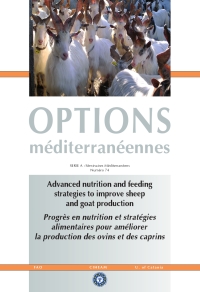| Article précédent | p. 101-105 | Article suivant |
Effects of olive cake, citrus pulp and wheat straw silage on milk fatty acid composition of Comisana ewes
The objective of this study was to evaluate the effects of partial replacement of conventional roughages with an ensiled-mixture made up of crude olive cake, orange pulp and wheat straw on fatty acid composition of ewe's milk. Thirty-six lactating Comisana ewes at about 150 days in milking, were divided into three homogenous groups (grass, G; silage 100, S100; and silage 50, S50) of 12 animals. Ewes of group G were allowed to graze pasture during the day and received hay plus concentrate on their return to the stall. The other two experimental groups were fed a mixed-diet containing silage, hay and concentrate. The silage was a mixture (% as fed) of 30% crude olive cake, 65% orange pulp and 5% wheat straw. The two silages differed only in the level of stone removal from the olive cake (100% in S100 and 50% in S50). The trial lasted 70 days preceded by a 21-day adaptation period to the experimental diets. Every 14 days individual milk samples of the complete morning milking were collected and analysed for fatty acid composition. In milk from S100 and S50 groups, the C18:0, C18:1 t9, C18:1 c9, C18:1 t11, C18:2 t9-c12, C20:0 and C20:3 n6 fatty acids increased significantly, while C6:0, C8:0, C10:0, C11:0, C12:0, C13:0, C14:0, C14:1, C15:0, C16:0, C18:2 c10-t12, C18:2 c9-t11 (CLA) and C18:3 n3 fatty acids decreased significantly in comparison to the G group. This trend has determined a significant decrease of the short (C6-C11) and medium-chain (C12-C17) fatty acids, an increase in UFA, in particular MUFA, and an improvement of the UFA/SFA ratio in milk of the S100 and S50 groups. The n-6 PUFA content was significantly higher in the milk of the S100 and S50 groups than in G group, while the n-3 PUFA one was significantly higher in the milk of group G. As a consequence, n-6/n-3 PUFA ratio was significantly higher in milk from S100 and S50 groups in comparison to G group.
L'objectif de cette étude était d'évaluer les effets du remplacement partiel de fourrages conventionnels par un mélange ensilé formé de tourteau d'olive brut, pulpe d'oranges et paille de blé sur la composition en acides gras du lait de brebis. Trente-six brebis Comisana en lactation à environ 150 jours de traite ont été divisées en trois groupes homogènes de 12 animaux (herbe, G ; ensilage 100, S100; et ensilage 50, S50). Les brebis du groupe G pouvaient pâturer pendant la journée et recevaient du foin et concentré lorsqu'elles revenaient à la bergerie. Les deux autres groupes expérimentaux recevaient une alimentation mixte contenant de l'ensilage, du foin et du concentré. L'ensilage était un mélange (% tel que distribué) de 30% de tourteau d'olive brut, 65% de pulpe d'oranges et 5% de paille de blé. Les deux ensilages différaient uniquement par le niveau d'élimination des noyaux du tourteau d'olive (100% dans S100 et 50% dans S50). L'essai a duré 70 jours précédés d'une période d'adaptation de 21 jours aux régimes expérimentaux. Tous les 14 jours, des échantillons individuels de lait de la traite complète du matin étaient prélevés et analysés pour connaître la composition en acides gras. Dans le lait des groupes S100 et S50, les acides gras C18:0, C18:1 t9, C18:1 c9, C18:1 t11, C18:2 t9-c12, C20:0 et C20:3 n6 augmentaient significativement, tandis que les acides gras C6:0, C8:0, C10:0, C11:0, C12:0, C13:0, C14:0, C14:1, C15:0, C16:0, C18:2 c10-t12, C18:2 c9-t11 (CLA) et C18:3 n3 baissaient significativement comparés au groupe G. Cette tendance a entraîné une diminution significative des acides gras à chaîne courte (C6-C11) et moyenne (C12-C17), une augmentation des UFA, en particulier MUFA, et une amélioration du rapport UFA/SFA dans le lait des groupes S100 et S50. La teneur en PUFA n-6 était significativement supérieure dans le lait des groupes S100 et S50 par rapport au groupe G, tandis que la teneur en PUFA n-3 était significativement supérieure dans le lait du groupe G. Comme conséquence, le rapport PUFA n-6/n-3 était significativement supérieur dans le lait des groupes S100 et S50 par rapport au groupe G.
- [ Afficher ]
- [ Télécharger ]
- [ Exporter la citation ]
Vous pouvez télécharger la citation au format :
- [ Imprimer ]
-
Mots-clés
ACIDE GRAS, ALIMENTATION DES ANIMAUX, BREBIS, ENSILAGE (PRODUIT), EXPERIMENTATION, LAIT, PAILLE DE BLE, REGIME ALIMENTAIRE, TOURTEAU D'OLEAGINEUXCiter cet article
Caparra P., Foti P., Scerra M., Postorino S., Vottari G., Cilione C., Scerra V., Sinatra M.C. Effects of olive cake, citrus pulp and wheat straw silage on milk fatty acid composition of Comisana ewes. In : Priolo A. (ed.), Biondi L. (ed.), Ben Salem H. (ed.), Morand-Fehr P. (ed.). Advanced nutrition and feeding strategies to improve sheep and goat . Zaragoza : CIHEAM, 2007. p. 101-105. (Options Méditerranéennes : Série A. Séminaires Méditerranéens; n. 74). 11. Seminar of the FAO-CIHEAM Sub-Network on Sheep and Goat Nutrition, 2005/09/08-10, Catania (Italy). http://om.ciheam.org/om/pdf/a74/00800362.pdf



